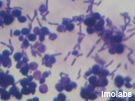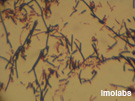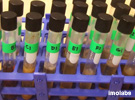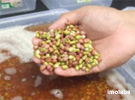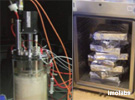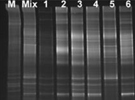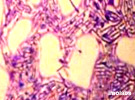Technology Highlights

Our technology is unique and inspired by tapping the knowledge and power of natural microbiomes. Starting from environmental samples, existing cultures in our collection or a mix of both, we use our proprietary Interactive Microbiome (i.microb) platform to directionally select and formulate microbial consortia which are able to achieve consistently high levels of functional efficacy in the field. Currently the i.microb platform can formulate 3 classes of microbia consortia, namely, rhizosynbiotics, envirosynbiotics and phytosynbiotics. These microbial consortia are robust as they blend and adapt better to the real environment and thus are able to survive, thrive and function more effectively.
- How It Works
- About Interactive Microbiomes
- About the i.microb platform
How the Technology Works
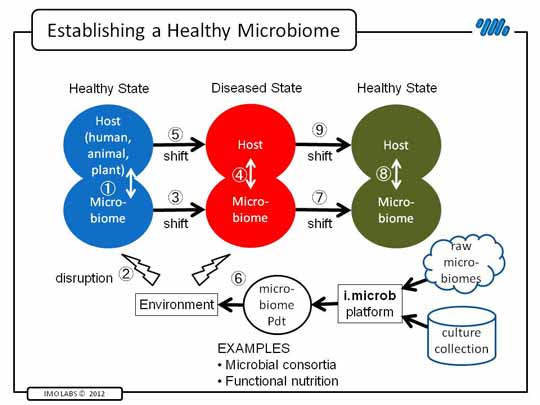
Stages 1, 2 and 3: Stable microbial communities associated with the "healthy" state of a host can be disrupted by altered environmental conditions. These environment changes induce population shift in the microbiome.
Stages 4 and 5: In addition to the observed population shifts, there are also structural changes and differences in the distribution of viable and nonviable bacteria associated with the change in environmental conditions, leading to a "diseased" state.
Stage 6: In the formulation of a solution to remedy the "diseased" state of the host, the i.microb platform is used to transform raw microbial communities from the environment, in combination with microbial cultures from IMO Labs' culture collection, into enriched microbial consortia, communities and microbiomes.
Stages 7, 8 and 9: The enriched microbial consortia is then introduced into the "diseased" environment where it causes disruption, inducing a new population shift in the host microbiome toward a new "healthy" state. This in turn causes the host to shift from the "diseased" state to a "healthy" state.
Microbiomes
All plants and animals, including humans, live and evolve in close association with microbial organisms. The interactions of plants and animals with their “microbiomes” – the totality of microbes, genomes and environmental interactions in a particular environment – are extremely complex. It is only recently that studies of entire microbial communities and their interactions have begun, made possible by advances in metagenomics. With the publication of initial findings, the important roles played by the microbes are becoming increasingly appreciated.
IMO Labs has tapped knowledge from the microbiomes and exploited their strength to successfully resolve condition-specific problems that have plagued many industries on a chronic basis. IMO Labs has successfully commercialised these solutions based on microbial communities in areas as diverse as agriculture, aquaculture, livestock, bioremediation, environment and human health. Our solutions inspired by microbiomes are indeed poised to overcome the productivity and sustainability challenges in the 21st century.
Microbial Consortia
|
A microbial consortium is a group of different species of microorganisms that work together in a complex system where all benefit from the activities of each other in the community. Microbial consortia are able to maintain a stable community structure when introduced into environmental situations. It is for this reason that microbial consortia are known to consistently outperform, in terms of reliability and efficacy, single strains of organisms or blended mixtures of microorganisms with diverse metabolic capabilities. |
Classes of Microbial Consortia
Over the years, IMO Labs has developed a vast body of technical knowhow and techniques to handle, preserve, analyze and manipulate microbial consortia and to manufacture them on an industrial scale. This body of knowledge, which IMO calls the Interactive Microbial Consortia or IMC technology, is brought to bear during the development of IMO Labs’ comprehensive range of natural biotechnology solutions and products.
The IMC technology consists of 3 main classes of microbial consortia:
-
Rhizosynbiotics. These are soil-based microbial communities which stimulate root and plant growth by rendering nutrients to be better absorbed by the plant.
-
Envirosynbiotics. These are microbial communities enriched and selected to degrade pollutants found in waste water, solid waste, hydrocarbon waste and chemical wastes.
-
Phytosynbiotics. These are plants fermented with probiotics, producing prebiotics in the process, which are effective in targeting bio-chemcial processes in the body. In animals, phytosynbiotics can promote healthy and quicker growth, improve feed conversion ratio and result in lean meat with less fat. In humans, phytosynbiotics can be used to address chronic condition-specific ailments such as high levels of blood glucose, uric acid and cholesterol.
Interactive Microbiome (i.microb) Platform
The Interactive Microbiome (i.microb) platform encompasses a body of IMO Labs' proprietary technologies which directionally select raw sets of microbial consortia and transform them into efficient, robust and consistent solutions in the field. The i.microb platform is responsive as new or improved formulations can be turned around quickly in a short period of time.
The unique features of the i.microb platform are described below:
|
Formulations based on Microbial Consortia |
|
|
Selection-Enrichment based on survival rather than performance/dominance |
|
|
Use of Complex Substrates |
|
|
Multi-Stage Liquid and Solid Fermentation |
|
|
Use of Community Genome Analysis - Metagenomics |
|
|
Micro-Encapsulation |
|
|
Database of microorganism properties |



